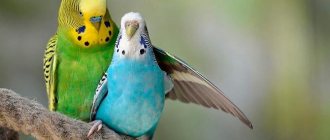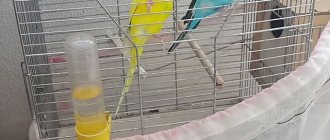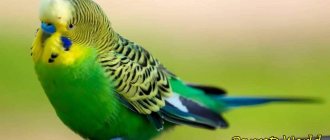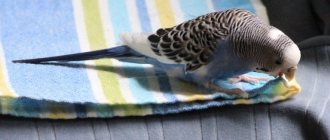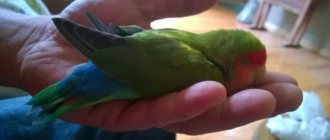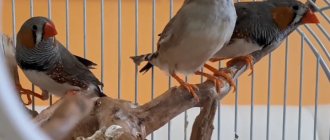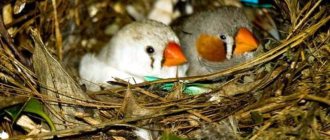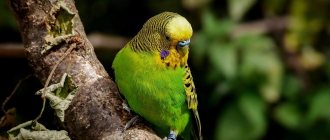Conditions for breeding
Budgerigars are ideal for breeding at home. Active birds have deservedly held the leadership among pets for many years, because they are friendly and cute. In addition, they do not irritate with loud screams, are peaceful and easy to care for. To successfully breed variegated wavy fish, you must adhere to certain rules.
Which parrots are suitable for breeding
Choosing a parrot for further procreation should be based on certain criteria:
- Health. A young, healthy individual has dense plumage, the feathers are not ruffled, they fit tightly to each other without bald spots.
- Appearance. The eyes should be black and shiny, and the beak with nostrils should be dry and clean. You should choose an active parrot that flies around the cage, plays and chirps. A sleepy, passive bird sitting on a perch with its eyelids closed is most likely seriously ill. It is not suitable for reproduction.
- Age. It is easier to expect offspring from a young bird. Parrots up to 3 months old have a clearly drawn wavy pattern at the base of the growth on the beak - the cere. From 3 to 8 months, a cap appears near the wax, and the waves disappear. A rim appears around the eyes, which is fully formed by 8 months. Further, it will become difficult to determine the age of the bird, since a parrot with a rim around its eyes can be either 8 months or 10 years old. For this reason, you should buy a parrot up to 8 months old. Males aged from one to 6 years, and females from 3 months are suitable for breeding.
- Plumage. As parrots age, they develop the habit of plucking feathers with their beaks, which is a sign of poor care. An inspection should be carried out to detect this habit, because it will be impossible to wean the bird from it.
- Voskovitsa. Young males have a lilac-colored wax, while females have white, blue or lilac.
Good offspring will come from active young parrots of medium size without obesity or frailty.
Matching
Budgerigars at home reproduce only after choosing partners. The task is complicated by the fact that, in addition to basic instinct, parrots adhere to personal tastes when choosing a partner.
Instructions for choosing a pair:
- Choose a similar shade of plumage for your partners.
- The older female is dominant. To prevent this from happening, it is better that the male is 2 years older. This age difference is optimal.
- Before the first meeting with the “lady,” the male must mature (maturation occurs after molting), and the female can be very young (3-4 months). An adult female can peck an immature partner.
- Try to choose partners of equal size and temperament.
- Be sure to agree with the seller before purchasing about the possibility of returning the bird if the partners are not suitable for each other.
- Let the couple adapt and get to know each other better. At this moment, skirmishes over food may arise between partners, so give each their own container of food. If the relationship doesn't work out, don't wait, but return the parrot and try again with a new partner.
The best period for mating
In the wild, parrots reproduce based on basic instinct, but in an apartment, the breeder needs to know the optimal timing for mating. The best time is summer and early autumn. Mating in early spring leads to the production of unhealthy offspring. The reason is the need for 14-16 hours of daylight for normal fetal development.
How do parrots behave during mating season?
To see how budgerigars mate, you need to place the young couple in a cage previously prepared for this and monitor their behavior. If the birds do not start fighting, pecking each other and tearing out feathers, then we can hope for the early appearance of offspring.
All the time of courtship, the male behaves funny - he combs his girlfriend’s feathers, feeds from his beak, chirps loudly and shows off in every possible way in front of her, taking various poses. You can understand that the female is also ready for mating by her behavior - she responds with mutual caresses, squints her eyes and constantly sits near her suitor.
On a note! Budgerigars are monogamous and, if they immediately reciprocate each other, their affection remains for life. Therefore, it is impossible to force birds to reproduce.
The mating itself occurs quite quickly, and in most cases the birds’ owners do not have time to notice it. Even if the male managed to impregnate the female the first time, parrots often continue to mate for several days. As experts recommend, the best period for such a process is from June to September, since it is at this time of year that there is enough solar heat, light and fresh fruits.
Preparation for masonry
In order for budgies to give birth to healthy offspring, you should prepare for the laying period.
Suitable conditions
The optimal duration of daylight hours is on average 16 hours. This condition is easily met in the summer, but in the fall infrared lamps are used for additional illumination. The temperature range at the cage installation site is from 20 to 30 degrees. The room with the cage should not be noisy. Prohibited: shouting, loud music, repairs.
Cage requirements
A comfortable cage contributes to the birth of strong offspring.
Important:
- Beginners in breeding wavy fish make a typical mistake by placing partners in a tight cage for quick rapprochement. The cramped space is uncomfortable for the birds, so they may not have any offspring.
- The minimum dimensions of a cage for partner parrots are: length - from 60 cm, width - 30 cm, height - 40 cm. An increase in the area is allowed, because after breeding, numerous offspring will live in the room.
- The cage requires 2 doors. Using the first, it is easy to set up a nest, and with the help of the second, it is easy to clean the cage, put food and drink.
- The nesting house is considered the most comfortable for the female to lay and raise offspring.
Nest house
The following types of houses are found in pet stores:
- Vertical. Perimeter – 20×20 cm, 25 cm high. Pros: the chicks will not be able to fly out of the nest early. The only downside is the high location of the exit, which risks damage to the female’s clutch.
- Horizontal. Dimensions 25x20x15 cm. The low entrance will not allow damage to the masonry, but the chicks may fall out of the house ahead of time.
- Compromise. Dimensions 20x25x20 cm. The area is convenient for the safe development of the clutch, the chicks will not fall out of the house, and the step at the bottom under the perch helps the female to sit on her eggs comfortably. The young grow in close quarters, but the chicks do not crush each other.
Additional recommendations:
- The minimum opening in the nest is 5 cm. If the female is picking at it, do not interfere, leave her the right to adjust the opening at her own discretion.
- The nest is hung outside or inside. Hanging it outside is convenient to save space when the cage is small, but the best option is to place the nest inside for a sense of security for the future parents.
- It is better that the house is made of solid spruce, pine or birch with an easily detachable lid for cleaning and disinfection.
- Plywood, chipboard and cardboard make the nesting house cold and are saturated with glue and chemicals, which is harmful to the birds’ bodies.
Disinfection
Accessories that parrots will need during the breeding period are disinfected. Drinking bowls, food containers and toys are dipped in boiling water with a weak percentage of “Whiteness”, then rinsed thoroughly. The nesting house is dismantled and washed with baby soap, dried and fried in the oven for 30-40 minutes at 120 degrees. Crushed chamomile is added to the sawdust sprinkled inside. This herbal remedy will prevent the appearance of gamas mites.
The right time for breeding
Experts say that the best time for parrots to start breeding is late spring. The daylight hours have increased and reach 15 hours, there is a lot of green food around and enough warmth. Until early autumn, you can plant parrots on clutches. It’s more difficult in winter, as additional lighting needs to be installed.
Experienced ornithologists do not advise preparing pairs for future offspring in early spring. The past winter has weakened them. The mating season for budgerigars will pass, but healthy offspring will not be produced. The body of the expectant mother needs vitamins in sufficient quantities. And in spring and summer, you can absolutely safely feed her with greens up to three times a day.
Nutrition
A balanced diet for budgies during mating and egg laying is required.
General rules
Female wavy birds require additional nutrition. In the wild, the “lady” is supplied with food by the male, but at home the owner should worry about this. When laying, a parrot spends a large amount of energy, and if there is a lack of nutrients, the embryos may remain underdeveloped or die.
Basic recommendations:
- The most balanced mixtures of grain crops are not able to replenish the reserves of all “building materials” in the form of amino acids, calcium, vitamins A, D, B and other minerals.
- Protein is included in the menu. Eggs are the best source of protein, and in combination with vegetables and shells they will help replenish the strength of a young mother, and she will more easily endure the laying period. To avoid excess protein, introduce complementary foods 2-3 times a week.
- For a strong shell, chicks need calcium, which is why females themselves should consume crushed shells. If there is a lack of calcium, the mother will peck at her own eggs.
- Fruits and vegetables are suppliers of vitamins and folic acid, which is necessary for the development of the bird’s body.
Make sure that the parrot and his partner are always fed, and that there is plenty of food in the feeders.
Recipes for mash during the breeding season
The following mash recipes will restore the balance of vitamins and minerals during the hatching period:
- rice porridge + carrots + apples + a quarter of a boiled egg + greens;
- lentil grains, millet, oats + grated beets + eggs;
- a mixture of boiled millet and oats + pearl barley + boiled egg + greens;
- bell pepper + grain sprouts + hamarus (freshwater crustacean);
- zucchini + carrots + greens + egg + steamed cereals;
- pumpkin + low-fat cottage cheese + broccoli + wheat sprouts.
Additionally, you should pay attention to the following points:
- Make sure there is chalk and any mineral mixture in the cage. As an alternative, birds obtain calcium from ground calcium gluconate tablets that are added to mixtures.
- As soon as egg laying stops, soft food is removed from the diet and the volume of grain feed is increased. Eggs are offered in small doses twice a week.
- 1-2 days before the birth of the offspring, the mother is again fed with eggs and vegetables rich in carotene: pumpkin, carrots, peppers, grain sprouts and herbs.
When mating occurs
Usually the birth of chicks occurs in the summer. During this period, parrots are provided with everything they need (sunlight, vitamins, comfortable temperature conditions).
In autumn and winter, it is also possible to bring parrots together and introduce them to each other. Extend daylight hours using artificial lighting to 16 hours. Make sure the room temperature is 20 degrees. Parrots need a complete, fortified diet so that the birth of chicks is not accompanied by any problems.
Male courtship
During mating games, the male's cere turns a bright blue hue, while that of the female turns brown, and increases in size. Changes in the cere are the result of a hormonal surge. The male begins active courtship of the female, and she may practically not eat, waiting for feeding from her partner.
Interesting! The courtship process looks funny: the male often nods his head and sings loudly. The couple begins to dance and talk together. At the same time, the male parrot taps with its beak on surrounding things and on the beak of the female. While dancing, the suitor makes interesting sounds, not forgetting to offer the lady food from his beak. This is a kind of demonstration of care that as soon as mating is over, the male will remain the guard and provider of food.
Nesting
After mating at home, the female will look for a quiet, dark place in a few days. Therefore, a special nest is installed in the cage. Its optimal size for budgies is 20*15*20 cm. Sawdust, dry grass or thin brushwood are suitable as bedding. They are laid out on the bottom of the cage, and then the bird independently carries them to the nest.
The female does not immediately get used to her house. At first, she may be hesitant to explore his inner space. Then it gets used to the nest and actively improves it. At this time, her belly is noticeably rounded, and the number of feathers decreases. To build a nest, the female tears out some of her own, even if there are enough auxiliary materials in the cage.
Incubation period
The incubation time for parrot eggs lasts 18 days. The first egg in the nesting house after fertilization appears 7 days later. The mother does not sit on the clutch right away, but tries to stay longer in the nest. The bird sits completely on the eggs after the second egg appears.
On the eve of the egg's appearance, the parrots chew the chalk harder, the mother becomes fatter, and the volume of her droppings increases. The parrot seems funny: with a round body and a trembling tail. She spends a long time rubbing herself in the corner of the cage, building a nest, and gnawing on all surrounding objects. The female's belly is exposed - a brooding spot that she will use to warm the eggs. The skin heats up and swells, causing the feathers to stand up.
Number of eggs
Laying occurs once every 2 days. On average, a female lays up to 7 eggs per clutch, but the optimal number is 5 eggs. At the same time, the mother heats all the eggs evenly, and the risk of frozen embryos is reduced. If you see a larger number of eggs, they are placed under another female or “hatched” in an incubator.
Hatching conditions
A bathing suit must be installed in the cage. In dry air, the female can independently regulate the optimal humidity with wet feathers.
Fruit identification
Fertilized and unfertilized eggs can be distinguished without candling. Fertilized ones are porcelain or white-gray in color, while unfertilized ones acquire a yellowish tint. The latter do not need to be immediately removed from the clutch, because they become a heating pad for others when the mother is away. But frozen eggs with embryos inside (recognized by a gray-brown tint with spots) must be removed immediately.
How long does it take for chicks to hatch?
The first chick is born 18-19 days after the eggs are laid. The weight of a hatched bird is 1 g. Parrots are born at different times, and development in the first days is quite rapid. As a result, by the time the last chick is born, the first one will be much larger than the others. If all the embryos are successfully hatched, there is a danger that the grown parrots will pass on the smaller ones.
Possible problems
Breeding parrots yourself is a very complex process that requires a huge amount of attention. In this case, a number of problems may arise that are characteristic of absolutely all breeds. It often happens that parrots simply do not begin to mate. Usually the problem is that suitable conditions have not been created for the birds. Maybe the daylight hours are too short (shorter than 15-16 hours), or the house for the chicks is not good enough.
If fertilization does not occur within a month, the house should be removed from the cage, otherwise it will not be perceived as an object necessary for reproduction.
Occasionally, a situation occurs when the female does not begin incubation. In this case, most often the problem is with the female; if she is not experienced, she will begin incubation from the second. In the case of the first clutch, there are also situations when the female lays eggs not in a specially designated house, but inside the cage. The best advice in this case is to replace the birdhouse with a new one.
The house can also become a battle area. This sometimes happens in the case of incorrectly determined gender - sometimes a male is mistaken for a female. If there is only one house for two young mothers, they will do their best to destroy their rival’s clutch.
If the female throws the eggs out of the nest, she most likely smelled a foreign scent on the surface.
Chick development
The harmonious development of young animals depends on proper maintenance and nutrition.
Care of offspring
Newborn parrots develop rapidly.
Care involves the following actions:
- Cleaning. When the chicks reach 2 weeks of age, you need to do a general cleaning of the nest: remove unfertilized eggs and all debris. Before this, transfer the babies to a warm box or small box. Inspect all chicks. Dirt sticks to their paws, which interferes with the normal growth of their limbs. You should immerse the babies' paws in warm water and let the dirt come off. Fresh birch sawdust is placed on the bottom, the chicks sit on them, and the house is installed in its old place. Clean the house as soon as possible to avoid overcooling the cubs.
- Nutrition of young animals. For the first 4-6 days, the female feeds the cubs with milk from the crop. After this, the food is softened grains, which the mother places in advance in the crop and feeds the children.
- Body mass. Weight increases fastest in the first 2 days. It increases by 200%. On the 23rd day, the greatest mass gain occurs, and a decrease in weight is observed due to the energetic body movements that the bird performs before the first flight.
- Departure. The first flight occurs on the 35th day. After this, the chicks are left with their mother for another 2 weeks.
When can you plant
Young animals may be diagnosed with the diseases “helicopter” and “splits” - curvature of the paws. The cause is staphylococcus infection or reproduction of closely related budgies. You can help the parrot only before it flies out of the house, so you should contact an ornithologist or veterinarian in time. 2 weeks after the start of flights, they are transplanted into a separate large cage. There the birds fly until sexual formation - molting.
How does nesting happen?
A few days after mating, you can determine by the behavior of the female whether the attempt was successful. The bird will look for a secluded nesting place in the home. During this period, the breeder should take care of installing a house for future offspring. It is believed that the optimal parameters for it are 22x15x20 cm. The structure should be well fixed, preferably under the roof of the cage.
Birds may not perceive the house at first and avoid it, but this is only temporary. In one or two days, the budgerigar, namely the female, will begin to explore it from all sides and establish its order in the structure. During this period, the male has other responsibilities - he takes care of the expectant mother, feeds her and chirps loudly.
At this time, it is necessary to provide the birds with sufficient quantities of thin twigs of various fruit trees; they are needed as building materials for the nest. Also, to arrange and insulate the house, birds often begin to tear out their feathers. This behavior is especially noticeable in female “wavy birds”.
Laying eggs
All of the above signs signal that the first egg should appear soon. During the nesting period, the couple should not be disturbed at all, much less touch the house, since there is a high risk that the female will then abandon her nest.
Quite a long time passes from the moment the house is mastered until the first egg appears - up to one month. After which the female begins to lay eggs every other day. There can be 4–6 of them in a clutch. This depends on the age of the parent parrots, genetic predisposition and environmental factors.
On a note! As a rule, budgerigars that breed in captivity lay 5 eggs. This is exactly the amount the female can evenly provide with body heat. If there are more eggs, professionals advise additionally using an incubator.
The appearance of offspring
The incubation period for the “wavy” eggs lasts no more than 18 days, the chicks appear the next day. After the birth of the first child, you should gradually exclude sprouted grains from the parrots’ menu, replacing its share with vegetables that are rich in carotene. It is also necessary to maintain a fairly high humidity in the room on such days - about 60%.
It often happens that not all eggs from a clutch have hatched, that is, they have frozen. If we are talking about 1-2 pieces, this is considered the norm. As a rule, this situation occurs if the female is too young and was unable to sufficiently heat the entire clutch. If not a single chick hatched, there may be plenty of reasons leading to this:
- infectious or chronic diseases of parents;
- poor quality or insufficient food and drink;
- poor conditions for keeping birds;
- genetic incompatibility of the couple.
The hatched chicks are very weak - they are not even able to hold their heads up, so they lie on their backs. Many breeders of wavy birds ask the question: is human help needed during this period? No, the female will be able to feed and warm them on her own.
Only two weeks after the birth of the last chick can the owner open the nesting house for cleaning. This must be done wearing rubber gloves very carefully and quickly while the female is outside the nest. Subsequent cleanings are then required once a week.
When are the chicks hatched?
It is customary to transfer grown chicks from adults no earlier than a month after their birth. During this period, they already independently leave the nesting shelter and confidently stand on their paws. In some cases, the chicks are removed from the female earlier. For example, when she begins to behave aggressively with them. If such behavior is noticed, the babies are fed artificially and are no longer allowed to see their mother.
To independently understand and see how “wavy animals” reproduce, no special skills are required. The main thing is to provide pets with timely care, hygiene and adequate nutrition.
Frozen or unfertilized eggs: causes
When there are 1-2 frozen eggs in a clutch, this is the norm. The female is sometimes physically unable to warm all future offspring. When there are a lot of frozen embryos, or all the embryos have disappeared, you need to think about it.
Reasons for embryo freezing:
- infectious diseases;
- unbalanced diet;
- water with chemical impurities;
- incompatibility of parental genetics;
- high or low humidity in the room;
- inability of the female to incubate.
Determination of egg fertilization
The first inspection of eggs occurs 6–7 days after laying. The presence of an embryo is determined using an ovoscope. The device examines the shell and allows you to determine the quality of embryo development.
Important! If you frequently pick up eggs or change their location, this has a negative effect on the embryo.
Eggs are checked no more often than every 4–5 days. Dangerous signs are the presence of cracks in the shell, stains and other damage, the presence of blood clots inside and mixing of the white and yolk.
Why don't parrots mate?
In certain situations, it is not possible to breed parrots because they refuse to mate.
Causes:
- When parrots do not like each other, the partners will not reproduce.
- It is a mistake for breeders to try to breed two males, because it is difficult to accurately determine the sex of a parrot. If two females live together, then laying eggs is possible, but there will be no embryos in them.
- The early age of the male is before molting. Even in the case of sympathy between parrots, if the male is immature, there will be no chicks.
- Unfertilized eggs will not appear due to the old age of the partners.
Breeding parrots can be organized in a city apartment. Proper nutrition, a comfortable cage and attention to pets will give you healthy and strong offspring.
Preparing the cage and nest
Breeding budgies requires careful preparation of the cage and all its elements. For example, a female, preparing for maternal responsibilities, begins to gnaw on everything she can reach. To avoid damage to cage parts and other accessories, it is recommended to put a vitamin stone and several twigs. Let her fulfill her need on them.
Each specialist recommends his own cage sizes. However, the minimum parameters are 40x30x40 cm. Insufficient space can interfere with the appearance of offspring. And if it is born, they may experience the aggression of their parents.
The cage is placed at eye level of the owner, this makes the birds safer and calmer. You should not place it near a microwave oven or gas stove.
The room where you decide to keep the parrots should be well ventilated, but at the same time avoid drafts. As soon as the parrots begin the nesting period, do not move the cage, do no repairs in this room, and do not produce sounds unusual for birds.
For the hygiene of the mother and future offspring, disinfection and sterilization are necessary: wipe with “White” and rinse the drinking bowl, feeder, and cage in warm water. The nest is washed using baby liquid soap, dried and heated in the oven at a temperature of about 130 degrees for 40 minutes. Mix sawdust with chamomile. This will repel gamas ticks.
We are preparing housing
Curiously, the appearance of a nesting house in a cage is considered a signal for parrots to reproduce. As soon as the couple examines the home from all sides, tastes the beak and approves, the period of courtship begins. Specialized stores sell two types of houses: those made of artificial materials and those made of wood.
Plastic nests are not cozy, durable or practical. Wooden houses have good heat transfer and a texture that is comfortable for parrots. There are three types of ready-made nests:
- Vertical house. Horizontal. Females are convenient for entry; the clutch is not damaged during the maturation period. The disadvantage is the low entrance hole, which provokes the early departure of the chicks from the nest.
- Vertical. The entrance hole is located high, the chicks will remain in the nest until they are fully formed, but there is a risk that when going inside the female will spoil the clutch.
- Compression. The most pet-friendly house. The structure is convenient for the female and the younger generation. An additional step keeps the masonry safe.
If desired, a nesting house can be made with your own hands. You will need two boards measuring 20*20 cm for the side walls, four boards 25*20 cm wide and high, two door hinges, self-tapping screws, a drill, a jigsaw and a screwdriver.
The boards must be well dried and treated to remove roughness and nicks.
Procedure:
- In the board intended for the bottom, make a 1-2 cm depression in the center for laying eggs.
- In the façade board in the upper corner, at a distance of 3 cm from the ceiling and wall, a taphole with a diameter of 5 cm is cut out. A step 3 cm high and 6 cm wide is nailed under it from the inside out.
- A hole is drilled between the entrance and the step for the perch. On the outside the perch protrudes 10 cm forward, from the inside by 1.5 cm.
- The side walls, front, rear wall and bottom are fastened with self-tapping screws every 10 cm.
- The lid is fixed on the door hinges on one side for ease of cleaning.
You will need sawdust for your home.
Sawdust from fruit trees, mixed with chamomile flowers, is poured into the bottom in a 1 cm layer. Often the nest is installed outside the cage, using the door as an entrance to the entrance. The decision is made by saving space inside the home. In general, this approach is not considered correct. The female sitting on the eggs is calmer if she hears the movements of her partner in the same territory.
Choose a healthy parrot.
Optimal age of parrots for breeding
Males become sexually mature at 10 months. Females are a little later, at 12 months.
The optimal age for mating budgerigars is considered to be from 1.5 to 4 years. At this age, females are more active and mobile, it is much easier for them to bear eggs and care for chicks. Males can participate in breeding for at least 10 years.
Carrying eggs and caring for chicks takes a lot of energy and exhausts the female’s body. Therefore, older females are very weak and can lay unfertilized eggs.
To get healthy offspring, the female is allowed to cross no more than 2 times a year.
Intimate moment: mating
When the male's mating behavior becomes pronounced, mating begins. The act is quick and often the owner does not notice the actions of the pets. Usually the female, offering herself, spreads out to a horizontal position. The partner sits on her back, hugging her with his wings and fertilizes. Depending on the physiological state of the pet, fertilization ends the first time, but sometimes it takes up to several weeks.
It’s curious, but for successful mating, 2-3 weeks before the act, the bird must fly for a long time. During walks, their metabolism increases, their muscles strengthen and their appetite increases.
